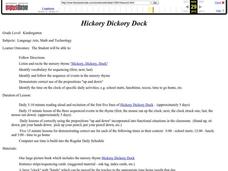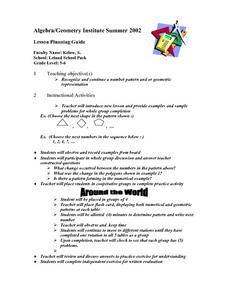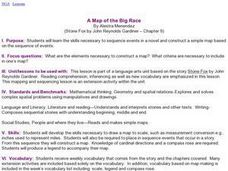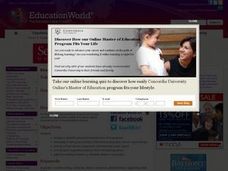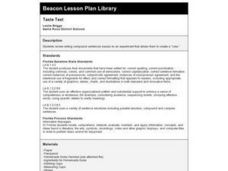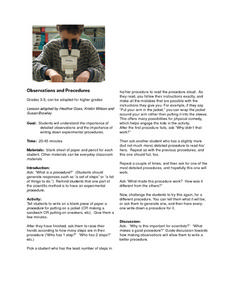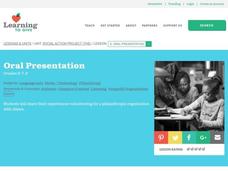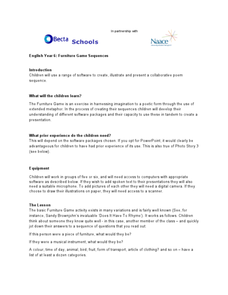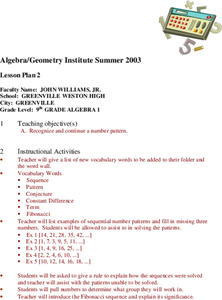Curated OER
Hickory Dickory Dock
Students use the Hickory Dickory Dock nursery rhyme to learn about rhyme, telling time, and preposition use. In this nursery rhyme instructional activity, students read the nursery rhyme daily and complete a Mother Goose quiz. Students...
Curated OER
2, 4, 6, 8 . . .What Do We Appreciate-Patterns, Patterns, Patterns
Students recognize patterns in a numerical sequence, create new patterns and predict outcomes to established sequences.
Curated OER
2, 4, 6, 8 . . .What Do We Appreciate-Patterns, Patterns, Patterns
Learners discover and predict patterns in a numerical sequence. Through the Internet and video segments, students begin with basic number patterns and extend their knowledge into higher math skills. They will also create new patterns...
Curated OER
Shell Sort; Serving up Seafood
Students complete various small group activities to classify items and determine the types of combinations that can be made with these items. In the second lesson, students create menus for a restaurant to help them gain money sense and...
Curated OER
Patterns and Geometric Representations
Students explore patterns and sequences. Given an example of each, they discuss their observations. In groups, students participate in an "Around the World" activity where they rotate to different stations in the classroom to determine...
Curated OER
Eensy Weensy Spider Lesson Plan
Students create their own versions of The Eensy-Weensy Spider. In this creative writing lesson plan, students read The Eensy-Weensy Spider and imagine what else the spider could do. Students then draw a picture depicting the spider...
Curated OER
Tukutuku Patterns
Students complete a series of lessons involving Tukutuku patterns, their rotations and area formulae. They determine the algebraic formulae for sequences. They use images as they work through the lessons to find the number of crosses in...
Curated OER
Story Boards
Students devise story boards to sequence the main events in a story. They draw a picture that demonstrates the main event in each chapter of a story and label it with a sentence.
Curated OER
A Map of the Big Race
Students read a novel and practice putting the events into the correct sequence. Using the text, they create a map showing the events of the race in order and a legend. They must use vocabulary from previous chapters and make their map...
Smithsonian Institution
A Ticket to Philly—In 1769: Thinking about Cities, Then and Now
While cities had only a small fraction of the population in colonial America, they played a significant role in pre-revolutionary years, and this was certainly true for the largest city in the North American colonies: Philadelphia. Your...
Curated OER
Chain Together A Book Report
Individuals examine a book's components, including key events, characters, and vocabulary and develop "chain book reports" with their peers. Strips of paper containing the book's important events are staples together and hung.
Curated OER
Poetry Reading for ELL Beginners
Bring the imagery of the desert to your classroom with this ELL lesson plan. After reading Madeleine Dunphy’s Here in the Southwestern Desert, learners complete a graphic organizer about the features and images of the poem. The...
Curated OER
Learning About Prediction
The skill of prediction as a reading strategy is explored. Learners are shown how to use clues within a story, along with pictures, to make predictions as to what's going to happen in the story. A clever in-class game which uses objects...
Curated OER
Beanie Baby Biographies
Learners write a biography for their favorite Beanie Babies and then share their biography out loud. A simple, yet effective idea! Everyone loves their Beanie Baby!
Curated OER
Insects
It's a fact: kids love bugs! With this lesson, young learners explore reading informational texts and conducting research while learning about their favorite insects. Spark learners' interest by reading a book about one kind of bug and...
Perkins School for the Blind
Placemats on Trays
Maybe the idea of putting placemats on trays doesn't sound that great, but it is, especially if you have a physical disability or are visually impaired. This task is one that can be used in a vocational setting and helps develop skills...
Curated OER
Taste Test - Combining Sentences
Learners combine sentences to create compound sentences. They write about creating their own soda, then make their own soda, comparing and contrasting it with a national brand. They write a paragraph containing compound sentences.
Curated OER
Observations and Procedures
Young scientists critique the breakdown of detailed observations. They discover the importance of writing down experimental procedures. There are some guided discussion questions at the end of the resource.
Curated OER
Oral Presentation
Practice public speaking in this oral presentation lesson plan. Middle schoolers list the characteristics of a powerful speaker. They watch a video of two speakers, compare them and discuss the qualities of a good speech. Afterwards,...
Curated OER
Sequencing the Cystic Fibrosis Gene: A Simulation
Ninth graders determine nucleotide sequences. They identify those base sequences that are normal, those that are normal variants and those that cause cystic fibrosis. Students use DNA nucleotide sequences to determine amino acid...
Curated OER
"Stomp"-Style Sequences
Learners develop patterns and combinations of movements into repeatable patterns. The video "Stomp Out Loud" with the percussive/dance group Stomp, is used to show students an example of the sequences they are going to create.
Curated OER
Ordinal Positions in a Sequence
Students study ordinal positions through class reading and discussion, complete an Animal Parade activity sheet and Internet activity to demonstrate knowledge about ordinal positions with 100% accuracy, and play a math computer game.
Curated OER
English Year 6: Furniture Game Sequences
Sixth graders create, illustrate and present a collaborative poem sequence using a variety of software.
Curated OER
Patterns and Sequences
Ninth graders examine sequential number patterns and the Fibonacci sequence. Given number patterns, they determine the next number in a sequence. Students develop their own number patterns and exchange them with another to be solved.
Other popular searches
- Story Sequencing Activities
- Free Sequencing Activities
- Pizza Sequencing Activities
- Math Sequencing Activities
- Sequencing Activities 3rd
- Sequencing Activities Apples
- Money Sequencing Activities
- English Sequencing Activities
- Recipe Sequencing Activities
- Reading Sequencing Activities
